Belkin F5D8231-4 N1 Wireless Router User Manual Table of Contents
Belkin International, Inc. N1 Wireless Router Table of Contents
Belkin >
Contents
- 1. Manual 1
- 2. Manual 2
Manual 1
N1 Wireless Router
Share your broadband Internet connection
User Manual
N1 Wireless Router
F5D8231-4
N1 Wireless Router.doc Page 1 of 100
N1 Wireless Router.doc Page 2 of 100
Introduction
Thank you for purchasing the Belkin N1 Wireless Router (the Router). Following
are two short sections—the first discusses the benefits of home networking, and
the other outlines best practices that maximize your wireless home network
range and performance. Please be sure to read through this User Manual
completely, and pay special attention to the section entitled “Placement of your
Wireless Networking Hardware for Optimal Performance” on the next page. By
following our simple setup instructions you will be able to use your Belkin Home
Network to:
• Share one high-speed Internet connection with all the computers in your
home
• Share resources, such as files and hard drives among all the connected
computers in your home
• Share a single printer with the entire family
• Share documents, music, video, and digital pictures
• Store, retrieve, and copy files from one computer to another
• Simultaneously play games online, check Internet email, and chat
Advantages of a Wireless Network
Here are some of the advantages of setting up a Belkin Wireless Network:
• Mobility – you’ll no longer need a dedicated “computer room”—now you
can work on a networked laptop or desktop computer anywhere within
your wireless range
• Easy installation – Belkin’s Easy Installation Wizard makes setup simple
• Flexibility – set up and access printers, computers, and other networking
devices from anywhere in your home
• Easy Expansion – the wide range of Belkin networking products let you
expand your network to include devices such as printers and gaming
consoles
• No cabling required – you can spare the expense and hassle of retrofitting
Ethernet cabling throughout the home or office
• Widespread industry acceptance – choose from a wide range of
interoperable networking products.
N1 Wireless Router.doc Page 3 of 100
N1 Wireless Router.doc Page 4 of 100
Placement of your N1 Wireless Router
Important Factors for Placement and Setup
Your wireless connection will be stronger the closer your computer is to your
Router (or access point). Typical indoor operating range for wireless devices is
between 100 and 200 feet.
In the same way, your wireless connection and performance will degrade
somewhat as the distance between your Router (or access point) and connected
devices increases. This may or may not be noticeable to you. As you move
further from your Router (or access point), connection speed may decrease.
Factors that can weaken signals simply by getting in the way of your network’s
radio waves are metal appliances or obstructions, and walls.
If you have concerns about your network’s performance that might be related to
range or obstruction factors, try moving the computer to a position between five
and 10 feet from the Router (or access point) in order to see if distance is the
problem. If difficulties persist even at close range, please contact Belkin
Technical Support.
Note: While some of the items listed below can affect network performance, they
will not prohibit your wireless network from functioning; if you are concerned that
your network is not operating at its maximum effectiveness, this checklist may
help.
1. Wireless Router (or Access Point) Placement
Place your Router (or access point), the central connection point of your network,
as close as possible to the center of your wireless network devices.
To achieve the best wireless network coverage for your “wireless clients” (i.e.,
computers enabled by Belkin Wireless Notebook Network Cards, Wireless
Desktop Network Cards, and Wireless USB Adapters):
• Ensure that your Router’s (or access point’s) networking antennas are
parallel to each other, and are positioned vertically (toward the ceiling). If
your Router (or access point) itself is positioned vertically, point the
antennas as much as possible in an upward direction.
• In multistory homes, place the Router (or access point) on a floor that is as
close to the center of the home as possible. This may mean placing the
Router (or access point) on an upper floor.
• Try not to place the Router (or access point) near a cordless 2.4GHz
phone.
2. Avoid Obstacles and Interference
Avoid placing your Router (or access point) near devices that may emit radio
“noise,” such as microwave ovens. Dense objects that can inhibit wireless
communication include:
• Refrigerators
• Washers and/or dryers
• Metal cabinets
• Large aquariums
• Metallic-based UV tinted windows
If your wireless signal seems weak in some spots, make sure that objects such
as these are not blocking the signal’s path (between your computers and Router
or access point)
3. Cordless Phones
If the performance of your wireless network is impaired after attending to the
above issues, and you have a cordless phone:
• Try moving cordless phones away from your Router (or access point) and
your wireless-enabled computers.
• Unplug and remove the battery from any cordless phone that operates on
the 2.4GHz band (check manufacturer’s information). If this fixes the
problem, your phone may be interfering.
• If your phone supports channel selection, change the channel on the
phone to the farthest channel from your wireless network. For example,
change the phone to channel 1 and move your Router (or access point) to
channel 11. See your phone’s user manual for detailed instructions.
• If necessary, consider switching to a 900MHz or 5GHz cordless phone.
N1 Wireless Router.doc Page 5 of 100
N1 Wireless Router.doc Page 6 of 100
4. Choose the “Quietest” Channel for your Wireless Network
In locations where homes or offices are close together, such as apartment
buildings or office complexes, there may be wireless networks nearby that can
conflict with yours.
Use the Site Survey capabilities found in the Wireless Utility of your wireless
adapter to locate any other wireless networks that are available (see your
wireless adapter’s user manual), and move your Router (or access point) and
computers to a channel as far away from other networks as possible.
• Experiment with more than one of the available channels, in order to find
the clearest connection and avoid interference from neighboring cordless
phones or other wireless devices.
• For Belkin wireless networking products, use the detailed Site Survey and
wireless channel information included with your wireless network card.
See your network card’s user guide for more information.
These guidelines should allow you to cover the maximum possible area with your
Router (or access point). Should you need to cover an even wider area, we
suggest the Belkin Wireless Range Extender/Access Point.
5. Secure Connections, VPNs, and AOL
Secure connections typically require a user name and password, and are used
where security is important. Secure connections include:
• Virtual Private Network (VPN) connections, often used to connect
remotely to an office network
• The “Bring Your Own Access” program from America Online (AOL), which
lets you use AOL through broadband provided by another cable or DSL
service
• Most online banking websites
• Many commercial websites that require a user name and password to
access your account
Secure connections can be interrupted by a computer’s power management
setting, which causes it to “go to sleep.” The simplest solution to avoid this is to
simply reconnect by rerunning the VPN or AOL software, or by re-logging into the
secure website.
A second alternative is to change your computer’s power management settings
so it does not go to sleep; however, this may not be appropriate for portable
computers. To change your power management setting under Windows, see the
“Power Options” item in the Control Panel.
If you continue to have difficulty with Secure Connections, VPNs, and AOL,
please review the steps above to be sure you have addressed these issues.
For more information regarding our networking products, visit our website at
www.belkin.com/networking or call Belkin Technical Support at:
USA: 877-736-5771
310-898-1100 ext. 2263
Europe: 00 800 223 55 460
Australia: 1800 235 546
New Zealand: 0800 235 546
Singapore: 800 616 1790
Product Overview
Product Features
In minutes you will be able to share your Internet connection and network your
computers. The following is a list of features that make your new Belkin N1
Wireless Router an ideal solution for your home or small office network.
Works with Both PCs and Mac® Computers
The Router supports a variety of networking environments including Mac OS®
8.x, 9.x, X v10.x, Linux®, Windows® 98, Me, NT®, 2000, and XP, and others. All
that is needed is an Internet browser and a network adapter that supports TCP/IP
(the standard language of the Internet).
Front-Panel LED Display
Lighted LEDs on the front of the Router indicate which functions are in operation.
You’ll know at-a-glance whether your Router is connected to the Internet. This
feature eliminates the need for advanced software and status-monitoring
procedures.
N1 Wireless Router.doc Page 7 of 100
N1 Wireless Router.doc Page 8 of 100
Web-Based Advanced User Interface
You can set up the Router’s advanced functions easily through your web
browser, without having to install additional software onto the computer. There
are no disks to install or keep track of and, best of all, you can make changes
and perform setup functions from any computer on the network quickly and
easily.
NAT IP Address Sharing
Your Router employs Network Address Translation (NAT) to share the single IP
address assigned to you by your Internet Service Provider while saving the cost
of adding additional IP addresses to your Internet service account.
SPI Firewall
Your Router is equipped with a firewall that will protect your network from a wide
array of common hacker attacks including IP Spoofing, Land Attack, Ping of
Death (PoD), Denial of Service (DoS), IP with zero length, Smurf Attack, TCP
Null Scan, SYN flood, UDP flooding, Tear Drop Attack, ICMP defect, RIP defect,
and fragment flooding.
Integrated 10/100 4-Port Switch
The Router has a built-in, four-port network switch to allow your wired computers
to share printers, data and MP3 files, digital photos, and much more. The switch
features automatic detection so it will adjust to the speed of connected devices.
The switch will transfer data between computers and the Internet simultaneously
without interrupting or consuming resources.
Universal Plug and Play (UPnP)
UPnP is a technology that offers seamless operation of voice messaging, video
messaging, games, and other applications that are UPnP-compliant.
Support for VPN Pass-Through
If you connect to your office network from home using a VPN connection, your
Router will allow your VPN-equipped computer to pass through the Router and to
your office network.
Built-In Dynamic Host Configuration Protocol (DHCP)
Built-In Dynamic Host Configuration Protocol (DHCP) on-board makes for the
easiest possible connection of a network. The DHCP server will assign IP
addresses to each computer automatically so there is no need for a complicated
networking setup.
Easy Install Wizard
The Easy Install Wizard takes the guesswork out of setting up your Router. This
automatic software determines your network settings for you and sets up the
Router for connection to your Internet Service Provider (ISP). In a matter of
minutes, your Router will be up and running on the Internet.
Note: Easy Install Wizard software is compatible with Windows 98SE, Me, 2000,
XP, and Mac OS X. If you are using another operating system, the Router can be
set up using the Alternate Setup Method described in this User Manual (see
page xx) [VERIFY PAGE NUMBER].
Integrated N1 Wireless Access Point
G Plus MIMO is an exciting new wireless technology that achieves data rates up
to 150/300Mbps. Actual throughput is typically lower than the connected data
rate and will vary depending on your networking environment.
MAC Address Filtering
For added security, you can set up a list of MAC addresses (unique client
identifiers) that are allowed access to your network. Every computer has its own
MAC address. Simply enter these MAC addresses into a list using the Web-
Based Advanced User Interface and you can control access to your network.
Knowing your Router
Package Contents
• Belkin N1 Wireless Router
• Quick Installation Guide
• Belkin Easy Install Wizard Software CD
• Belkin RJ45 Ethernet Networking Cable
• Power Supply
• User Manual
System Requirements
• Broadband Internet connection such as a cable or DSL modem with RJ45
(Ethernet) connection
• At least one computer with an installed network interface adapter
• TCP/IP networking protocol installed on each computer
• RJ45 Ethernet networking cable
• Internet browser
N1 Wireless Router.doc Page 9 of 100
N1 Wireless Router.doc Page 10 of 100
Easy Install Wizard Software System Requirements
• A PC running Windows® 98SE, Me, 2000, or XP, or a Mac® computer
running Mac OS® X
• Minimum 64MB RAM
• Internet browser
Knowing your Router
The Router has been designed to be placed on a desktop. All of the cables exit
from the rear of the Router for better organization and utility. The LED indicators
are easily visible on the TOP of the Router to provide you with information about
network activity and status.
A. Wireless Network LED
OFF Wireless network is OFF
Blue Wireless network is ready
Blinking Indicates wireless activity
B. Wired Computer Status LEDs
When a computer is properly connected to one of the wired computer ports on
the rear of the Router, the LED will light. When information is being sent over the
port, the LED blinks rapidly.
OFF No device is linked to the port
Blue 10Base-T device connected
Blinking Port activity
C. Modem/WAN Status LED
This LED lights in BLUE to indicate that your modem is connected properly to the
Router. It blinks rapidly when information is being sent over the port between the
Router and the modem.
OFF No WAN link
Solid Blue Good WAN link
Blinking Blue WAN activity
D. Internet/Connected LED
This unique LED shows you when the Router is connected to the Internet. When
the light is OFF, the Router is NOT connected to the Internet. When the light is
blinking, the Router is attempting to connect to the Internet. When the light is
solid BLUE, the Router is connected to the Internet. When using the “Disconnect
after x minutes” feature, this LED becomes extremely useful in monitoring the
status of your Router’s connection.
N1 Wireless Router.doc Page 11 of 100
N1 Wireless Router.doc Page 12 of 100
OFF Router is not connected to the Internet
Blinking Blue Router is attempting to connect to the Internet
Solid Blue Router is connected to the Internet
E. Power/Router LED
When you apply power to the Router or restart it, a short period of time elapses
while the Router boots up. During this time, the “Power/Router” LED blinks.
When the Router has completely booted up, the “Power/Router” LED becomes a
SOLID light, indicating the Router is ready for use.
OFF Router is OFF
Blinking Blue Router is booting up
Solid Blue Router is ready
---------------------------------------------------------------------------------------------
[insert rear panel line art with F to I line up to the ports]
F. Power Jack – Black
Connect the included 12V/0.5A DC power supply to this jack.
G. Connections to Computers (Wired Computer Ports) – Gary
Connect your wired (non-wireless) computers to these ports. These ports are
RJ45, 10/100 auto-negotiation, auto-uplinking ports for standard UTP category 5
or 6 Ethernet cable. The ports are labeled 1 through 4. These ports correspond
to the numbered LEDs on the front of the Router.
H. Connection to Modem (Modem Port) – Yellow
This port is for connection to your cable or DSL modem. Use the cable that was
provided with the modem to connect the modem to this port. Use of a cable other
than the cable supplied with the cable modem may not work properly.
I. Reset Button
The “Reset” button is used in rare cases when the Router may function
improperly. Resetting the Router will restore the Router’s normal operation while
maintaining the programmed settings. You can also restore the factory default
settings by using the “Reset” button. Use the restore option in instances where
you may have forgotten your custom password.
a. Resetting the Router
Push and release the “Reset” button. The lights on the Router will momentarily
flash. The “Power/Ready” light will begin to blink. When the “Power/Ready” light
becomes solid again, the reset is complete.

b. Restoring the Factory Defaults
Press and hold the “Reset” button for at least 10 seconds, then release it. The
lights on the Router will momentarily flash. The “Power/Ready” light will begin to
blink. When the “Power/Ready” light becomes solid again, the restore is
complete.
---------------------------------------------------------------------------------------------
Connecting and Configuring your Router
Verify the contents of your box. You should have the following:
• Belkin N1 Wireless Router
• Category 5 Networking Cable (for connecting the Router to the computer)
• Power Supply
• Belkin Easy Install Wizard Software CD
• User Manual
Modem Requirements
Your cable or DSL modem must be equipped with an RJ45 Ethernet port. Many
modems have both an RJ45 Ethernet port and a USB connection. If you have a
modem with both Ethernet and USB, and are using the USB connection at this
time, you will be instructed to use the RJ45 Ethernet port during the installation
procedure. If your modem has only a USB port, you can request a different type
of modem from your ISP, or you can, in some cases, purchase a modem that has
an RJ45 Ethernet port on it.
Ethernet USB
Easy Install Wizard
Belkin has provided our Easy Install Wizard software to make installing your
Router a simple and easy task. You can use it to get your Router up and running
in minutes. The Easy Install Wizard requires that your Windows 98SE, Me, 2000,
or XP computer be connected directly to your cable or DSL modem and that the
Internet connection is active and working at the time of installation. If it is not,
you must use the “Alternate Setup Method” section of this User Manual to
configure your Router. Additionally, if you are using an operating system other
than Windows 98SE, Me, 2000, or XP, you must set up the Router using the
“Alternate Setup Method” section of this User Manual.
IMPORTANT: Run the Easy Install Wizard from the computer that is directly connected to the cable or
DSL modem. DO NOT CONNECT THE ROUTER AT THIS TIME.
N1 Wireless Router.doc Page 13 of 100
N1 Wireless Router.doc Page 14 of 100
Step 1 Run the Easy Install Wizard Software
1. Shut down any programs that are running on your computer at this time.
2. Make sure you have the following items at the computer that is now directly
connected to the cable or DSL modem. DO NOT CONNECT THE ROUTER
AT THIS TIME.
• The Easy Install Wizard CD-ROM
• The Router
• The Router Power Supply
• Category 5 Networking Cable
• This User Manual
3. Turn off any firewall or Internet-connection-sharing software on your
computer.
Windows User: Insert the Easy Install Wizard software CD into your CD-ROM
drive. The Network Setup Utility screen will automatically appear on your screen
within 15 seconds. Click on “Run the Easy Install Wizard” to begin.
<Insert: 0-Flash.tif>[use current image]
Select your region from the drop-down box shown on the screen.
<Insert: 1-SelectRegion.tif>[use current image]
Note for Windows Users: If the Easy Install Wizard does not start up
automatically, select your CD-ROM drive from “My Computer” and double-click
on the file named “Start” to start the Network Setup Utility.
Mac OS Users: Insert the Easy Install Wizard software CD into your CD-ROM
drive. Click on the CD icon; a folder will pop up. To begin, click on “start.osx” if
you have Mac OS X.
4. Follow the Easy Install Wizard to complete the installation.
Welcome Screen
After you insert the CD into your CD-ROM drive, the Wizard’s welcome screen
will appear. Make sure you have not connected the Router at this point. If you
have connected your Router, please reconnect your computer directly to the
modem. Click “Next” when you are ready to move on.
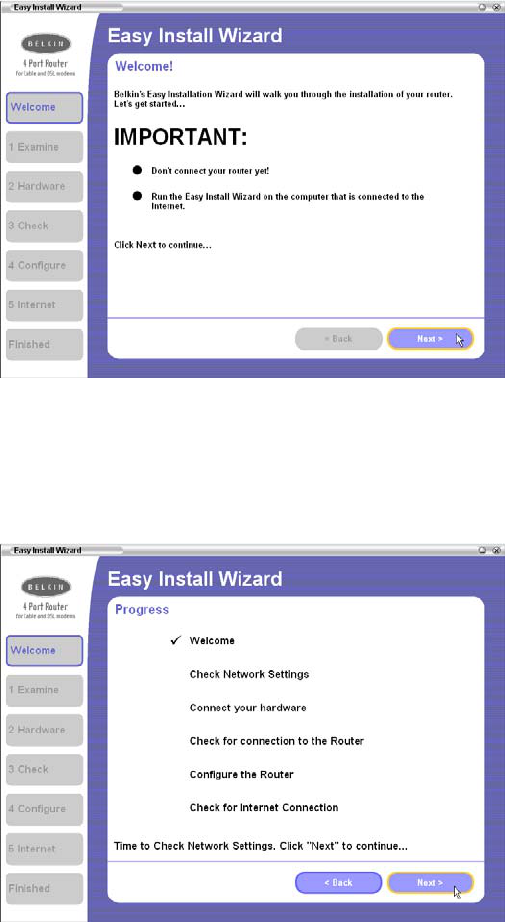
Progress Screen
Easy Install will show you a progress screen each time a step in the setup has
been completed. Each time you see the progress screen, click “Next” when you
are ready to move to the next step.
N1 Wireless Router.doc Page 15 of 100
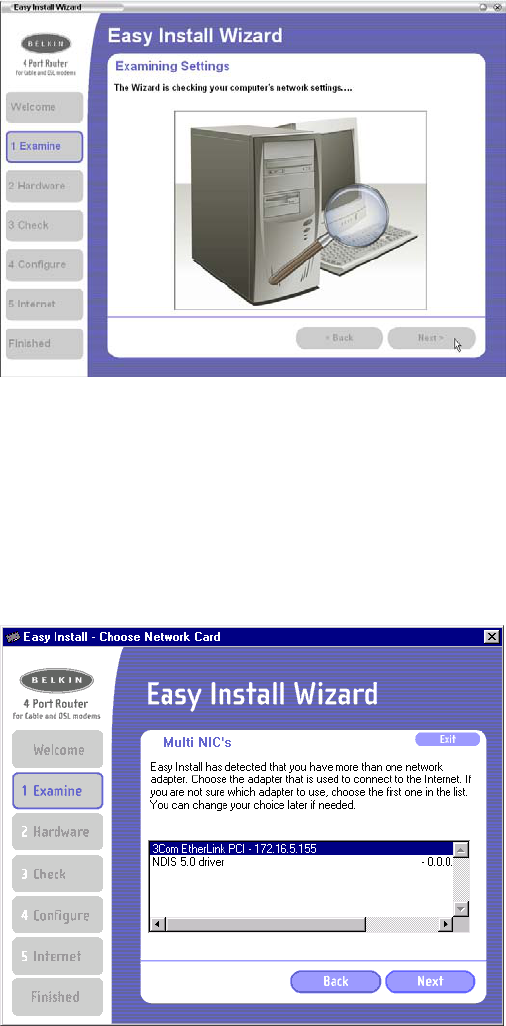
N1 Wireless Router.doc Page 16 of 100
1.1 Examining Settings
The Wizard will now examine your computer’s network settings and gather
information needed to complete the Router’s connection to the Internet. When
the Wizard is finished examining your computer, click “Next” to continue.
1.2 Multi-NICs Screen
This screen will appear ONLY if you have more than one network adapter
installed in your computer. If you have more than one network adapter
installed in your computer, the Wizard will need to know which adapter is
connected to your modem. Select the network card that is connected to your
modem from the list and click “Next”. If you are not sure which adapter to
choose, select the adapter at the top of the list. If you mistakenly choose the
wrong adapter now, you will be able to choose a different one later.
Step 2: Hardware Setup - Connect the Router to your Modem and Computer

The Wizard will walk you through connecting your Router to your computer
and modem. Follow the steps on the screen using the pictures as a guide.
2.1 This step instructs you to locate the cable connected between your
modem and the networking port on your computer. Unplug this cable from
the computer and plug it into the BLUE port on the Router. Click “Next” to
continue.
2.2 This step instructs you to locate the YELLOW cable that is included with
your Router. Plug one end of this cable into ANY one of the YELLOW
ports on your Router. Plug the other end of the cable into the networking
port on your computer. Click “Next” to continue.
N1 Wireless Router.doc Page 17 of 100
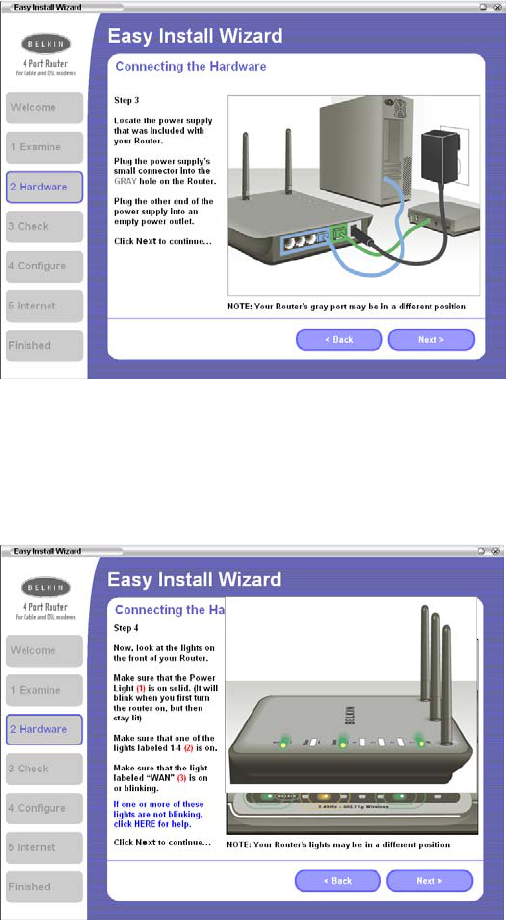
N1 Wireless Router.doc Page 18 of 100
2.3 This step instructs you to locate the power supply that is included with
your Router. Plug the power supply’s small connector into the GRAY port
on the Router. Plug the power supply into an empty power outlet. Click
“Next” to continue.
2.4 This step instructs you to look at the lights on the front of your Router.
Make sure the appropriate lights are ON. Refer to the Easy Install Wizard
software on your computer’s screen for more details. Click “Next” to
continue.
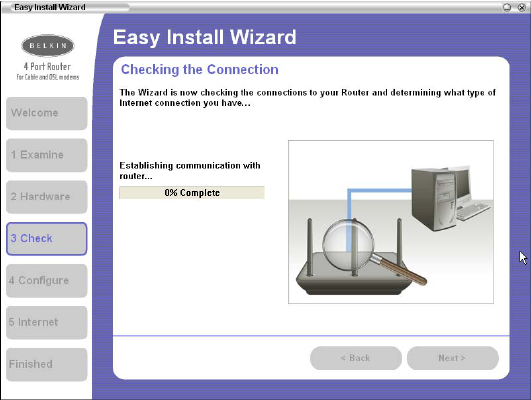
Step 3: Checking the Connection
3.1 Once you have completed connecting the Router, the Wizard will check the
connection to the Router then go on to determine what type of Internet
connection you have.
N1 Wireless Router.doc Page 19 of 100
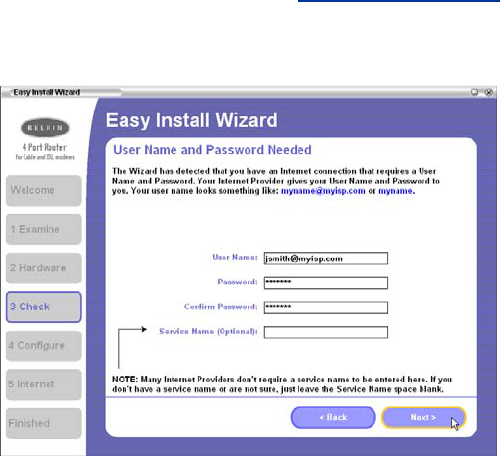
N1 Wireless Router.doc Page 20 of 100
3.2 User Name and Password Needed
If you have a connection type that requires a user name and a password, the
Wizard will ask you to type in your user name and password. If your
connection type does not require a user name and password, you will not
see this screen.
Your user name and password is provided to you by your Internet Service
Provider. If you have to type in a user name and password to connect to the
Internet, then type that same user name and password in here. Your user
name looks something like “jsmith@myisp.com” or simply “jsmith”. The
service name is optional and is very rarely required by your ISP. If you don’t
know your service name, leave this blank. When you have entered your
information, click “Next” to move on.
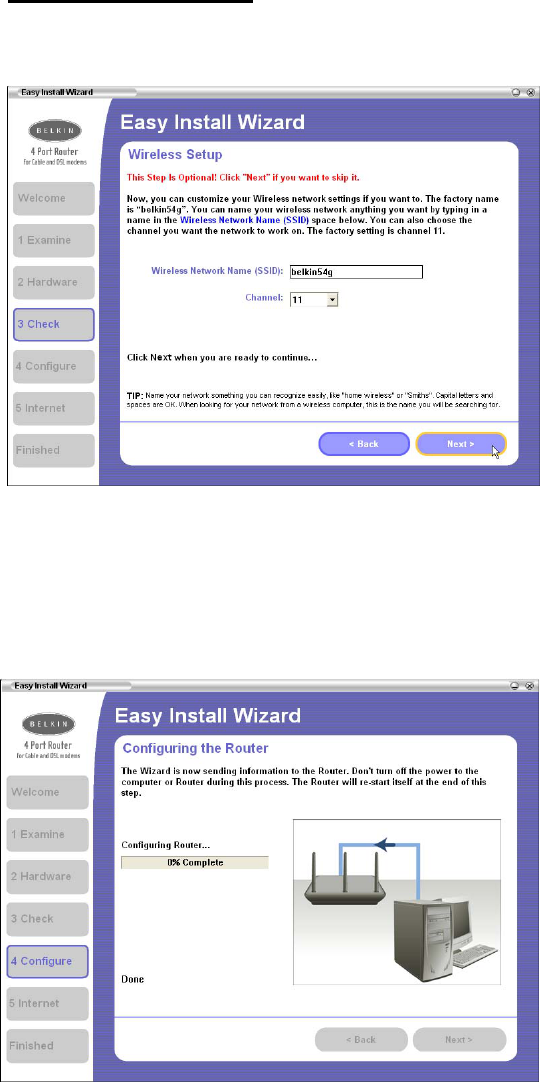
3.3 Wireless Setup
This Step Is Optional. Click “Next” if you want to skip it.
Using this step, you can customize your wireless network settings if you want
to. Follow the steps on the screen to complete this step. Click “Next” to
continue.
Step 4: Configuring the Router
The Wizard will now transfer all of the configuration information to the Router.
This will take approximately one minute. During this time, do not turn off the
Router or computer. The Router will restart itself at the end of this step.
N1 Wireless Router.doc Page 21 of 100
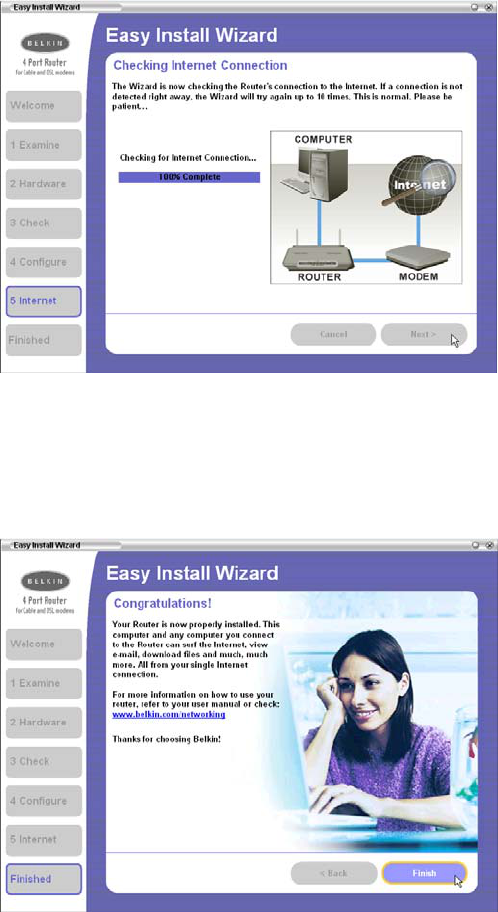
N1 Wireless Router.doc Page 22 of 100
4.1 Checking Internet
The Wizard will now check for an Internet connection. This can take a few
minutes. The Wizard may not detect a connection right away. If not, it will
retry a number of times. The “Connected” light on the front panel of the
Router will flash during this time. Please be patient through this process.
4.2 Finished
When the Internet connection is complete, the Wizard will tell you that you
are finished. The “Connected” LED on the front of the Router will be solid
BLUE, indicating that the Router is now connected to the Internet.
Your Router is now connected to the Internet. Now you can begin surfing the
Internet by opening your browser and going to your favorite web page.
Congratulations! You have finished installing your new Belkin Router. You are
ready to set up the other computers in your home. You can also add computers
to your Router any time you want.
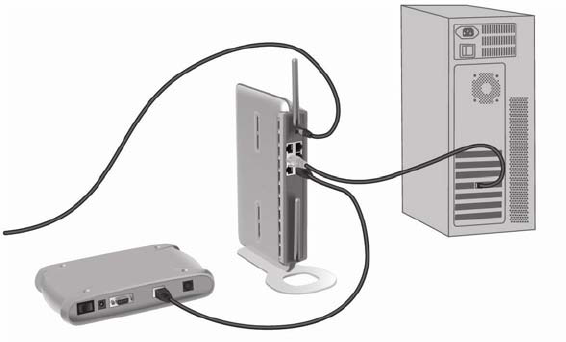
Alternate Setup Method
Step 1: Connecting your Gateway Router
1.1 Turn off the power to your modem by unplugging the power supply from
the modem.
1.2 Locate the network cable that is connected between your modem and
your computer and unplug it from your computer, leaving the other end
connected to your modem.
1.3 Plug the loose end of the cable you just unplugged into the port on the
back of the Router labeled “Internet/WAN”.
1.4 Connect the included network cable from the back of the computer to one
of the ports labeled “1–4”. Note: It does not matter which numbered port
you choose.
1.5 Turn your cable or DSL modem on by reconnecting the power supply to
the modem.
1.6 Before plugging the power cord into the Router, plug the cord into the wall,
then plug the cord into the Router’s power jack.
Mac or PC computer
that was originally
connected to the cable
or DSL modem
To power adapter Supplied Blue Ethernet
cable (to computer)
Cable or DSL
modem Existing network
cable (that came
with modem)
N1 Wireless Router.doc Page 23 of 100
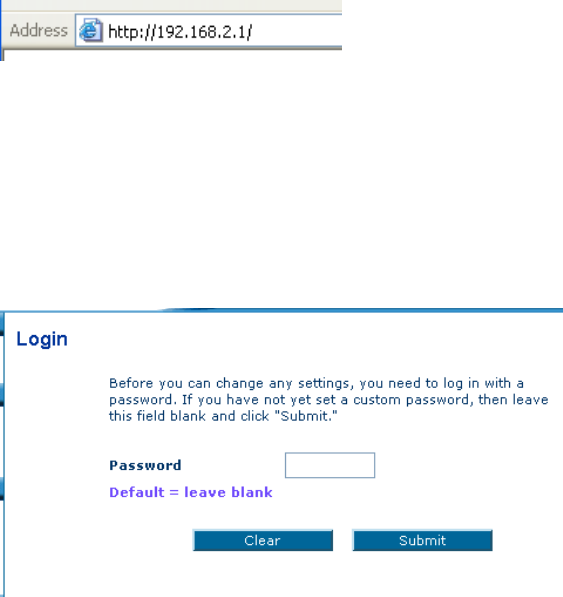
N1 Wireless Router.doc Page 24 of 100
1.7 Verify that your modem is connected to the Router by checking the lights
on the TOP of the Router. The Blue light labeled “WAN” should be ON if
your modem is connected correctly to the Router. If it is not, recheck your
connections.
1.8 Verify that your computer is connected properly to the Router by checking
the lights labeled “LAN 1,2,3,4”. The light which corresponds to the
numbered port connected to your computer should be ON, if your
computer is connected properly. If it is not, recheck your connections.
Alternate Setup Method
Step 2: Set your Computer’s Network Settings to Work with a DHCP Server
See the section in this User Manual called “Manually Configuring Network
Settings” for directions.
Alternate Setup Method
Step 3: Configuring the Router Using the Web-Based Advanced User
Interface
Using your Internet browser, you can access the Router’s Web-Based Advanced
User Interface. In your browser, type “192.168.2.1” (do not type in anything else
such as “http://” or “www”). Then press the “Enter” key.
Logging into the Router
You will see the Router’s home page in your browser window. The home page is
visible to any user who wants to see it. To make any changes to the Router’s
settings, you have to log in. Clicking the “Login” button or clicking on any one of
the links on the home page will take you to the login screen. The Router ships
with no password entered. In the login screen, leave the password blank and
click the “Submit” button to log in.
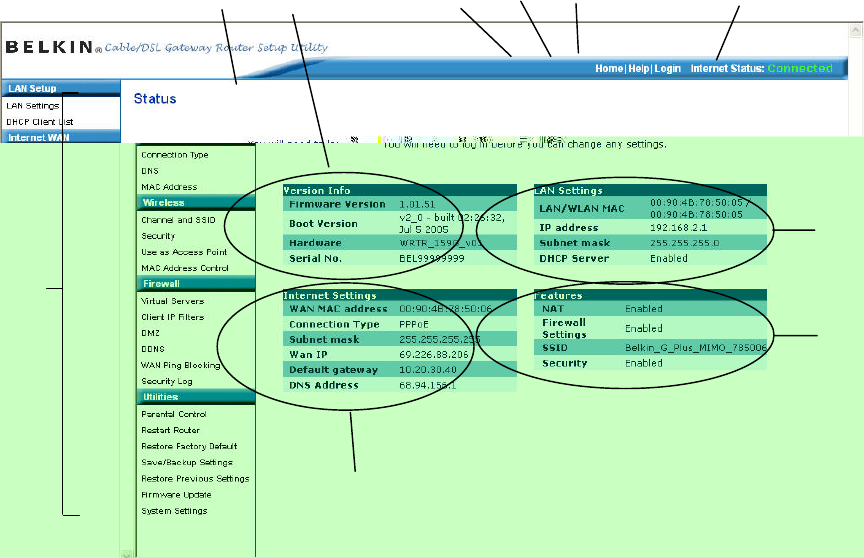
Logging out of the Router
One computer at a time can log into the Router for the purposes of making
changes to the settings of the Router. Once a user has logged in to make
changes, there are two ways that the computer can be logged out. Clicking the
“Logout” button will log the computer out. The second method is automatic. The
login will time out after a specified period of time. The default login time-out is 10
minutes. This can be changed from one to 99 minutes. For more information, see
the section in this manual titled “Changing the Login Time-Out Setting”.
Understanding the Web-Based Advanced User Interface
The home page is the first page you will see when you access the Advanced
User Interface (UI). The home page shows you a quick view of the Router’s
status and settings. All advanced setup pages can be reached from this page.
(2) (5) (3)
(4)
(9)
(8)
(10)
(1)
(6)
(7)
[replace with 8231-Status.jpg]
1. Quick-Navigation Links
You can go directly to any of the Router’s advanced UI pages by clicking directly
on these links. The links are divided into logical categories and grouped by tabs
to make finding a particular setting easier to find. Clicking on the purple header of
each tab will show you a short description of the tab’s function.
N1 Wireless Router.doc Page 25 of 100
N1 Wireless Router.doc Page 26 of 100
2. Home Button
The home button is available in every page of the UI. Pressing this button will
take you back to the home page.
3. Internet Status Indicator
This indicator is visible in all pages of the Router, indicating the connection status
of the Router. When the indicator says “connection OK” in BLUE, the Router is
connected to the Internet. When the Router is not connected to the Internet, the
indicator will read “no connection” in RED. The indicator is automatically updated
when you make changes to the settings of the Router.
4. Login/Logout Button
This button enables you to log in and out of the Router with the press of one
button. When you are logged into the Router, this button will change to read
“Logout”. Logging into the Router will take you to a separate login page where
you will need to enter a password. When you are logged into the Router, you can
make changes to the settings. When you are finished making changes, you can
log out of the Router by clicking the “Logout” button. For more information about
logging into the Router, see the section called “Logging into the Router”.
5. Help Button
The “Help” button gives you access to the Router’s help pages. Help is also
available on many pages by clicking “more info” next to certain sections of each
page.
6. LAN Settings
Shows you the settings of the Local Area Network (LAN) side of the Router.
Changes can be made to the settings by clicking on any one of the links (IP
Address, Subnet Mask, DHCP Server) or by clicking the “LAN” quick-navigation
link on the left side of the screen.
7. Features
Shows the status of the Router’s NAT, firewall, and wireless features. Changes
can be made to the settings by clicking on any one of the links or by clicking the
quick-navigation links on the left side of the screen.
8. Internet Settings
Shows the settings of the Internet/WAN side of the Router that connects to the
Internet. Changes to any of these settings can be made by clicking on the links or
by clicking on the “Internet/WAN” quick-navigation link on the left side of the
screen.
9. Version Info
Shows the firmware version, boot-code version, hardware version, and serial
number of the Router.
10. Page Name
The page you are on can be identified by this name. This User Manual will
sometimes refer to pages by name. For instance “LAN > LAN Settings” refers to
the “LAN Settings” page.
N1 Wireless Router.doc Page 27 of 100
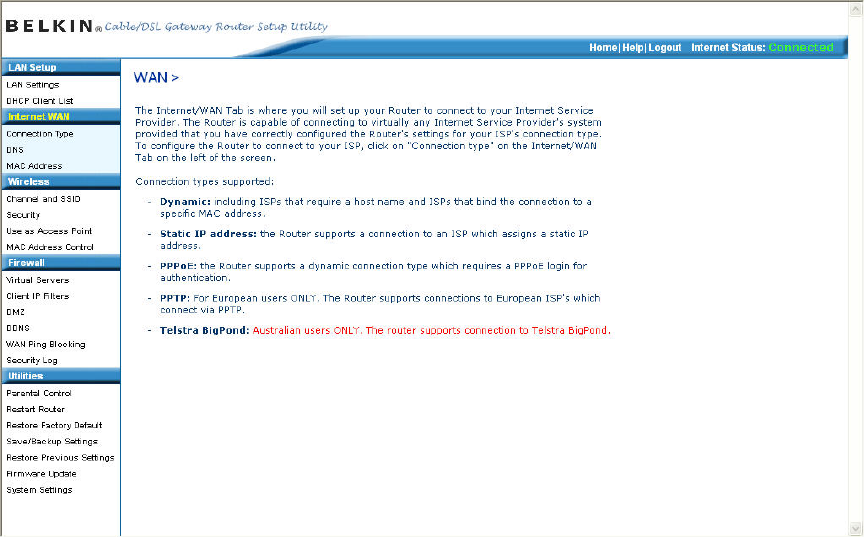
N1 Wireless Router.doc Page 28 of 100
Step 4: Configuring your Router for Connection to your Internet Service
Provider (ISP)
The “Internet/WAN” tab is where you will set up your Router to connect to your
Internet Service Provider (ISP). The Router is capable of connecting to virtually
any ISP’s system provided you have correctly configured the Router’s settings for
your ISP’s connection type. Your ISP connection settings are provided to you by
your ISP. To configure the Router with the settings that your ISP gave you, click
“Connection Type” (A) on the left side of the screen. Select the connection type
you use. If your ISP gave you DNS settings, clicking “DNS” (B) allows you to
enter DNS address entries for ISPs that require specific settings. Clicking “MAC
Address” (C) will let you clone your computer’s MAC address or type in a specific
WAN MAC address, if required by your ISP. When you have finished making
settings, the “Internet Status” indicator will read “connection OK” if your Router is
set up properly.
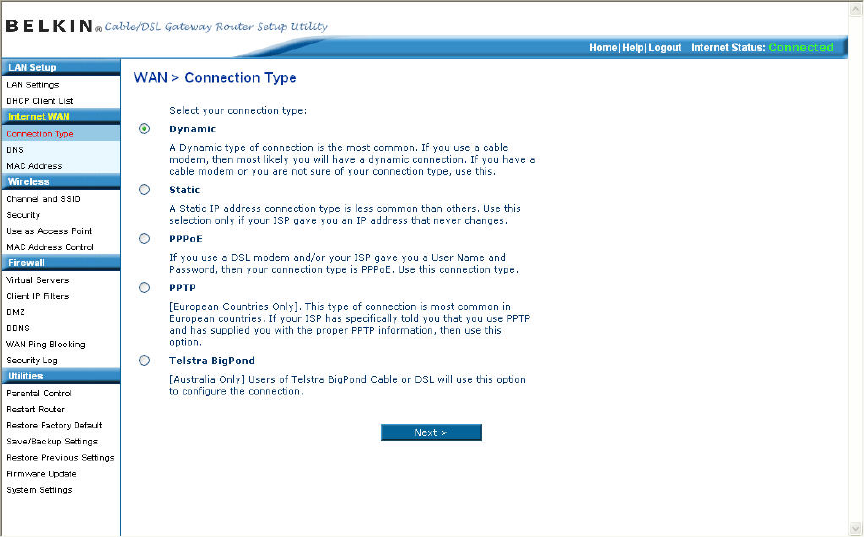
Setting your Connection Type
From the “Connection Type” page, you can select the type of connection you
use. Select the type of connection you use by clicking the button (1) next to your
connection type and then clicking “Next” (2).
N1 Wireless Router.doc Page 29 of 100
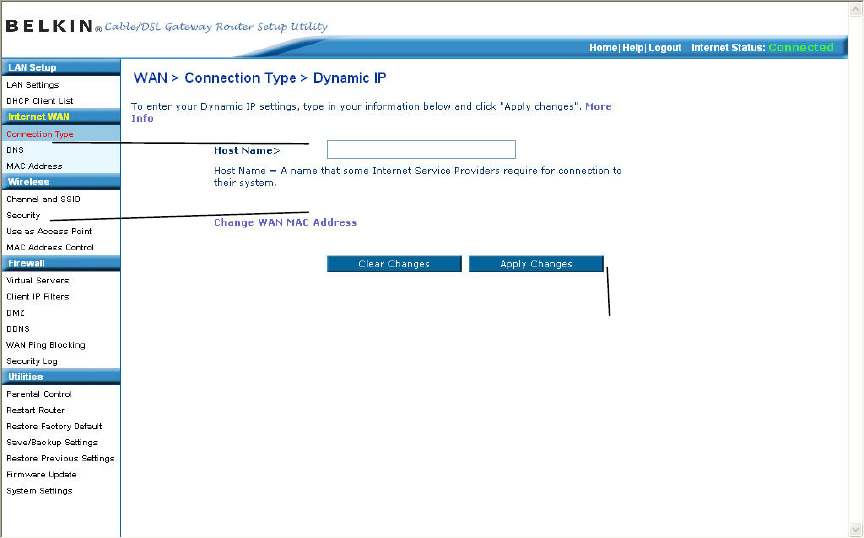
N1 Wireless Router.doc Page 30 of 100
Setting your Internet Service Provider (ISP) Connection Type to Dynamic IP
A dynamic connection type is the most common connection type found with cable
modems. Setting the connection type to “dynamic” in many cases is enough to
complete the connection to your ISP. Some dynamic connection types may
require a host name. You can enter your host name in the space provided if you
were assigned one. Your host name is assigned by your ISP. Some dynamic
connections may require that you clone the MAC address of the PC that was
originally connected to the modem.
1. Host Name
This space is provided to enter a host name that needs to be visible to your ISP.
Enter your host name here and click “Apply Changes” (3). If your ISP did not
assign you a host name, or you are not sure, leave this blank.
2. Change WAN MAC Address
If your ISP requires a specific MAC address to connect to the service, you can
enter a specific MAC address or clone the current computer’s MAC address
through this link.
(1)
(2)
(3)
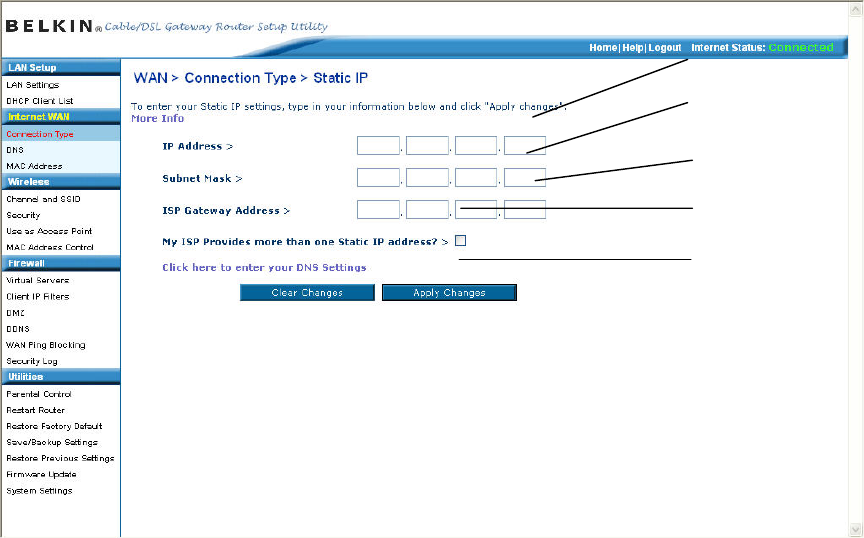
Setting your Internet Service Provider (ISP) Connection Type to Static IP
A static IP address connection type is less common than other connection types.
If your ISP uses static IP addressing, you will need your IP address, subnet
mask, and ISP gateway address. This information is available from your ISP or
on the paperwork that your ISP left with you. Type in your information, then click
“Apply Changes” (3). After you apply the changes, the Internet Status indicator
will read “connection OK” if your Router is set up properly.
1. IP Address
Provided by your ISP. Enter your IP address here.
2. Subnet Mask
Provided by your ISP. Enter your subnet mask here.
3. ISP Gateway Address
Provided by your ISP. Enter the ISP gateway address here.
4. My ISP Provides More Than One Static IP Address
If your ISP assigns you more than one static IP address, your Router is capable
of handling up to five static WAN IP addresses. Select “My ISP provides more
than one static IP address” and enter your additional addresses.
(1)
(2)
(3)
(4)
(5)
N1 Wireless Router.doc Page 31 of 100
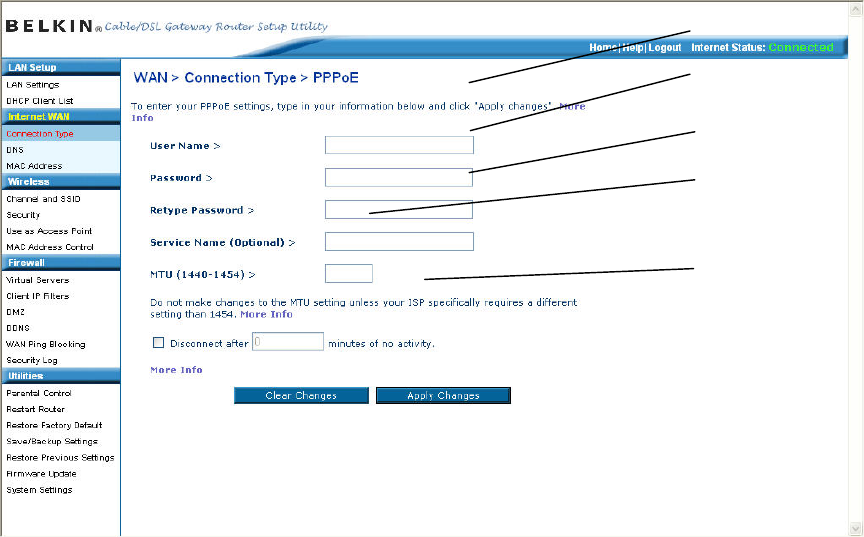
N1 Wireless Router.doc Page 32 of 100
Setting your ISP Connection Type to PPPoE
Most DSL providers use PPPoE as the connection type. If you use a DSL
modem to connect to the Internet, your ISP may use PPPoE to log you into the
service. If you have an Internet connection in your home or small office that
doesn’t require a modem, you may also use PPPoE.
Your connection type is PPPoE if:
1) Your ISP gave you a user name and password, which is required to connect to
the Internet.
2) Your ISP gave you software such as WinPOET or Enternet300 that you use to
connect to the Internet.
3) You have to double-click on a desktop icon other than your browser to get on
the Internet.
(1)
(2)
(3)
(4)
(5)
1. User Name
This space is provided to type in your user name that was assigned by your ISP.
2. Password
Type in your password and retype it into the “Retype Password” box to confirm it.
3. Service Name
A service name is rarely required by an ISP. If you are not sure if your ISP
requires a service name, leave this blank.
4. MTU
The MTU setting should never be changed unless your ISP gives you a specific
MTU setting. Making changes to the MTU setting can cause problems with your
Internet connection including disconnection from the Internet, slow Internet
access, and problems with Internet applications working properly.
5. Disconnect after X...
The “Disconnect” feature is used to automatically disconnect the Router from
your ISP when there is no activity for a specified period of time. For instance,
placing a check mark next to this option and entering “5” into the minute field will
cause the Router to disconnect from the Internet after five minutes of no Internet
activity. This option should be used if you pay for your Internet service by the
minute.
N1 Wireless Router.doc Page 33 of 100
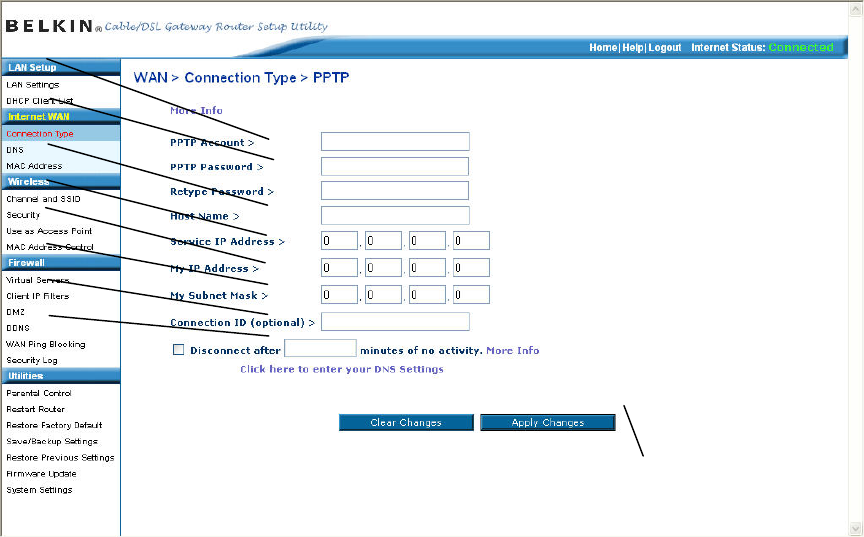
N1 Wireless Router.doc Page 34 of 100
Setting your Internet Service Provider (ISP) Connection Type to Point-to-
Point Tunneling Protocol (PPTP) [European Countries Only].
Some ISPs require a connection using PPTP protocol, a type of connection most
common in European countries. This sets up a direct connection to the ISP’s
system. Type in the information provided by your ISP in the space provided.
When you have finished, click “Apply Changes” (9). After you apply the changes,
the Internet Status indicator will read “connection OK” if your Router is set up
properly.
(1)
(2)
(3)
(4)
(5)
(6)
(7)
(8)
(9)
1. PPTP Account
Provided by your ISP. Enter your PPTP account name here.
2. PPTP Password
Type in your password and retype it into the “Retype Password” box to confirm it.
3. Host Name
Provided by your ISP. Enter your host name here.
4. Service IP Address
Provided by your ISP. Enter your service IP address here.
5. My IP Address
Provided by your ISP. Enter the IP address here.
6. My Subnet Mask
Provided by your ISP. Enter the IP address here.
7. Connection ID (optional)
Provided by your ISP. If your ISP did not give you a connection ID, leave this
blank.
8. Disconnect after X….
The “Disconnect” feature is used to automatically disconnect the Router from
your ISP when there is no activity for a specified period of time. For instance,
placing a check mark next to this option and entering “5” into the minute field will
cause the Router to disconnect from the Internet after five minutes of no Internet
activity. This option should be used if you pay for your Internet service by the
minute.
N1 Wireless Router.doc Page 35 of 100
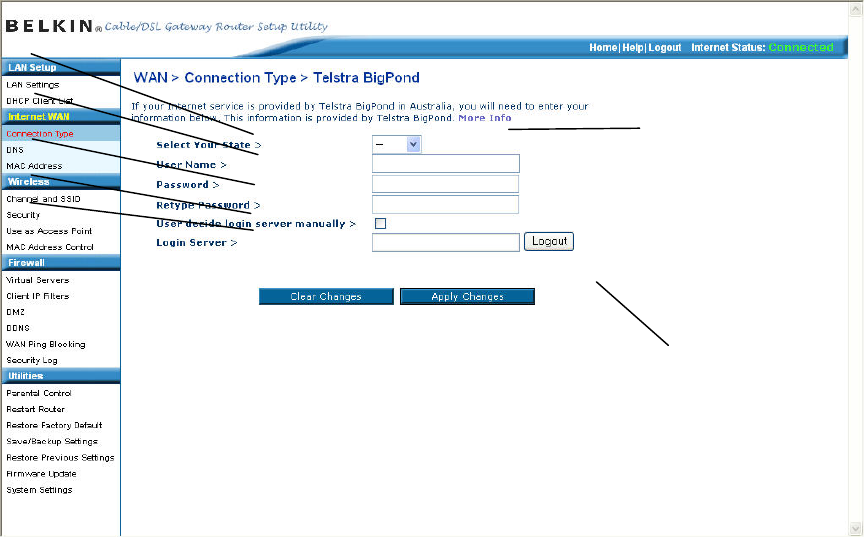
N1 Wireless Router.doc Page 36 of 100
Setting your Connection Type if You Are a Telstra® BigPond User [Australia
Only]
Your user name and password are provided to you by Telstra BigPond. Enter this
information below. Choosing your state from the drop-down menu (6) will
automatically fill in your login server IP address. If your login server address is
different than one provided here, you may manually enter the login server IP
address by placing a check in the box next to “User decide login server manually”
(4) and type in the address next to “Login Server” (5). When you have entered all
of your information, click “Apply Changes” (7). After you apply the changes, the
Internet Status indicator will read “connection OK” if your Router is set up
properly.
(1)
(2)
(3)
(4)
(5)
(6)
(7)
1. Select your State
Select your state from the drop-down menu (6). The “Login Server” box will
automatically be filled in with an IP address. If for some reason this address does
not match the address that Telstra has given, you can manually enter the login
server address. See “User decide login server manually” (4).
2. User Name
Provided by your ISP. Type in your user name here.
3. Password
Type in your password and retype it into the “Retype Password” box to confirm it.
4. User Decide Login Server Manually
If your login server IP address is not available in the “Select Your State” drop-
down menu (6), you may manually enter the login server IP address by placing a
check in the box next to “User decide login server manually” and type in the
address next to “Login Server” (5).
Setting Custom Domain Name Server (DNS) Settings
A “Domain Name Server” is a server located on the Internet that translates
Universal Resource Locaters (URLs) like “www.belkin.com” to IP addresses.
Many Internet Service Providers (ISPs) do not require you to enter this
information into the Router. The “Automatic from ISP” box (1) should be checked
if your ISP did not give you a specific DNS address. If you are using a static IP
connection type, then you may need to enter a specific DNS address and
secondary DNS address for your connection to work properly. If your connection
type is dynamic or PPPoE, it is likely that you do not have to enter a DNS
address. Leave the “Automatic from ISP” box checked. To enter the DNS
address settings, uncheck the “Automatic from ISP” box and enter your DNS
entries in the spaces provided. Click “Apply Changes” (2) to save the settings.
N1 Wireless Router.doc Page 37 of 100
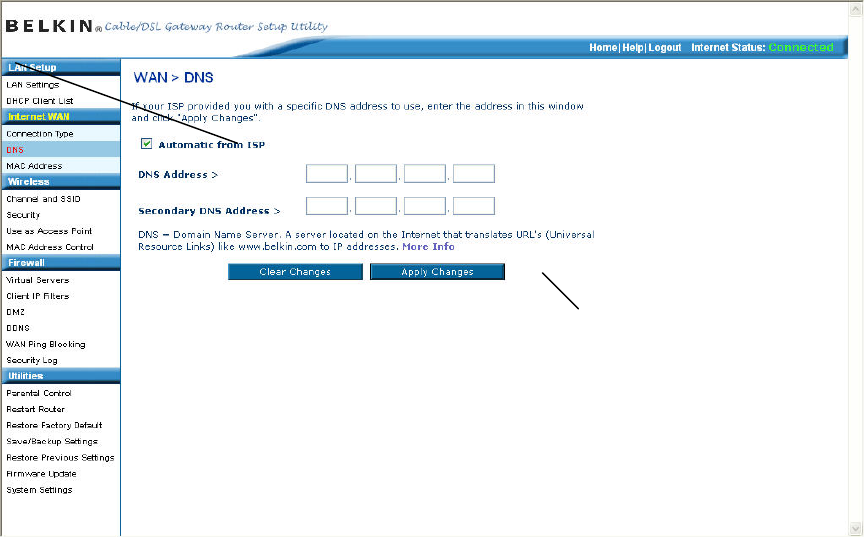
N1 Wireless Router.doc Page 38 of 100
(1)
(2)
Configuring your WAN Media Access Controller (MAC) Address
All network components including cards, adapters, and routers, have a unique
“serial number” called a MAC address. Your Internet Service Provider (ISP) may
record the MAC address of your computer’s adapter and only let that particular
computer connect to the Internet service. When you install the Router, its own
MAC address will be “seen” by the ISP and may cause the connection not to
work. Belkin has provided the ability to clone (copy) the MAC address of the
computer into the Router. This MAC address, in turn, will be seen by the ISP’s
system as the original MAC address and will allow the connection to work. If you
are not sure whether your ISP needs to see the original MAC address, simply
clone the MAC address of the computer that was originally connected to the
modem. Cloning the address will not cause any problems with your network.
Cloning your MAC Address
To clone your MAC address, make sure that you are using the computer that was
ORIGINALLY CONNECTED to your modem before the Router was installed.
Click the “Clone” button (1). Click “Apply Changes” (3). Your MAC address is
now cloned to the Router.
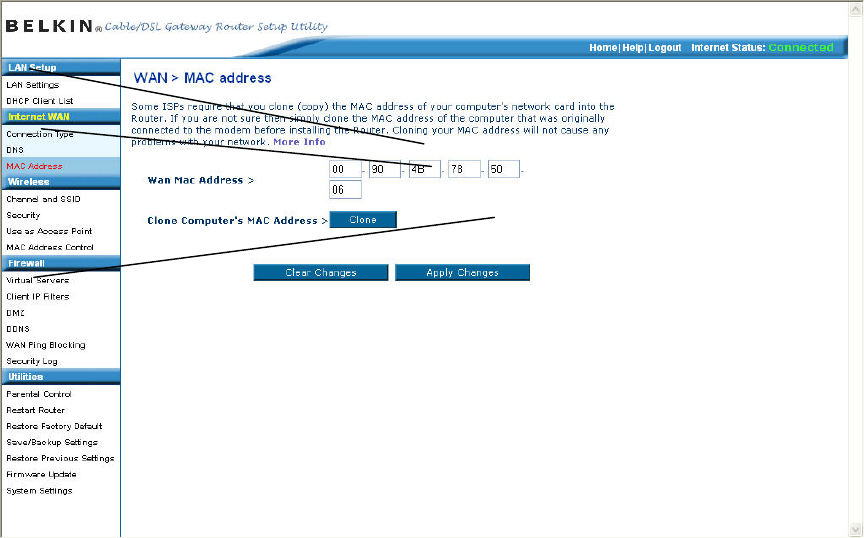
Entering a Specific MAC Address
In certain circumstances you may need a specific WAN MAC address. You can
manually enter one in the “MAC Address” page. Type in a MAC address in the
spaces provided (2) and click “Apply Changes” (3) to save the changes. The
Router’s WAN MAC address will now be changed to the MAC address you
specified.
(1)
(2)
(3)
N1 Wireless Router.doc Page 39 of 100
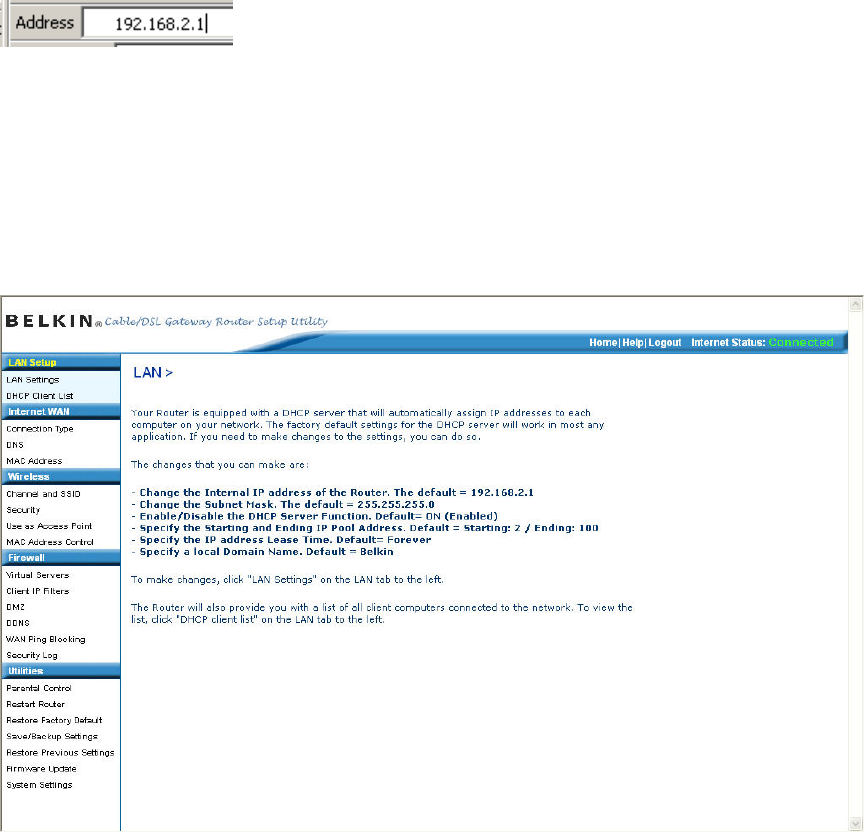
N1 Wireless Router.doc Page 40 of 100
Using the Web-Based Advanced User Interface
Using your Internet browser, you can access the Router’s Web-Based Advanced
User Interface. In your browser, type “192.168.2.1” (do not type in anything else
such as “http://” or “www”) then press the “Enter” key.
You will see the Router’s home page in your browser window.
Viewing the LAN Settings
Clicking on the header of the LAN tab (1) will take you to the LAN tab’s header
page. A quick description of the functions can be found here. To view the settings
or make changes to any of the LAN settings, click on “LAN Settings” (2) or to
view the list of connected computers, click on “DHCP client list” (3).
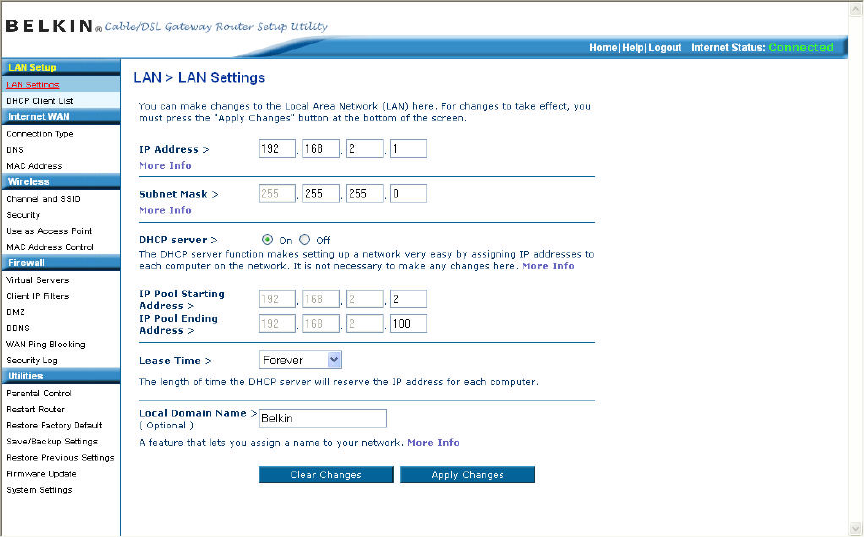
Changing LAN Settings
All settings for the internal LAN setup of the Router can be viewed and changed
here.
1. IP Address
The “IP address” is the internal IP address of the Router. The default IP
address is “192.168.2.1”. To access the advanced setup interface, type this
IP address into the address bar of your browser. This address can be
changed if needed. To change the IP address, type in the new IP address
and click “Apply Changes”. The IP address you choose should be a non-
routable IP. Examples of a non-routable IP are:
192.168.x.x (where x is anything between 0 and 255)
10.x.x.x (where x is anything between 0 and 255)
2. Subnet Mask
There is no need to change the subnet mask. This is a unique, advanced
feature of your Belkin Router. It is possible to change the subnet mask if
necessary; however, do NOT make changes to the subnet mask unless you
have a specific reason to do so. The default setting is “255.255.255.0”.
3. DHCP Server
The DHCP server function makes setting up a network very easy by
assigning IP addresses to each computer on the network automatically. The
default setting is “On”. The DHCP server can be turned OFF if necessary;
however, in order to do so you must manually set a static IP address for each
N1 Wireless Router.doc Page 41 of 100
N1 Wireless Router.doc Page 42 of 100
computer on your network. To turn off the DHCP server, select “Off” and click
“Apply Changes”.
4. IP Pool
The range of IP addresses set aside for dynamic assignment to the
computers on your network. The default is 2–100 (99 computers). If you want
to change this number, you can do so by entering a new starting and ending
IP address and clicking on “Apply Changes”. The DHCP server can assign
100 IP addresses automatically. This means that you cannot specify an IP
address pool larger than 100 computers. For example, starting at 50 means
you have to end at 150 or lower so as not to exceed the 100-client limit. The
starting IP address must be lower in number than the ending IP address.
5. Lease Time
The length of time the DHCP server will reserve the IP address for each
computer. We recommend that you leave the lease time set to “Forever”. The
default setting is “Forever”, meaning that any time a computer is assigned an
IP address by the DHCP server, the IP address will not change for that
particular computer. Setting lease times for shorter intervals such as one day
or one hour frees IP addresses after the specified period of time. This also
means that a particular computer’s IP address may change over time. If you
have set any of the other advanced features of the Router such as DMZ or
client IP filters, these are dependent on the IP address. For this reason, you
will not want the IP address to change.
6. Local Domain Name
The default setting is “Belkin”. You can set a local domain name (network
name) for your network. There is no need to change this setting unless you
have a specific advanced need to do so. You can name the network anything
you want such as “MY NETWORK”.
Viewing the DHCP Client List Page
You can view a list of the computers (known as clients), which are connected to
your network. You are able to view the IP address (1) of the computer, the host
name (2) (if the computer has been assigned one), and the MAC address (3) of
the computer’s network interface card (NIC). Pressing the “Refresh” (4) button
will update the list. If there have been any changes, the list will be updated.
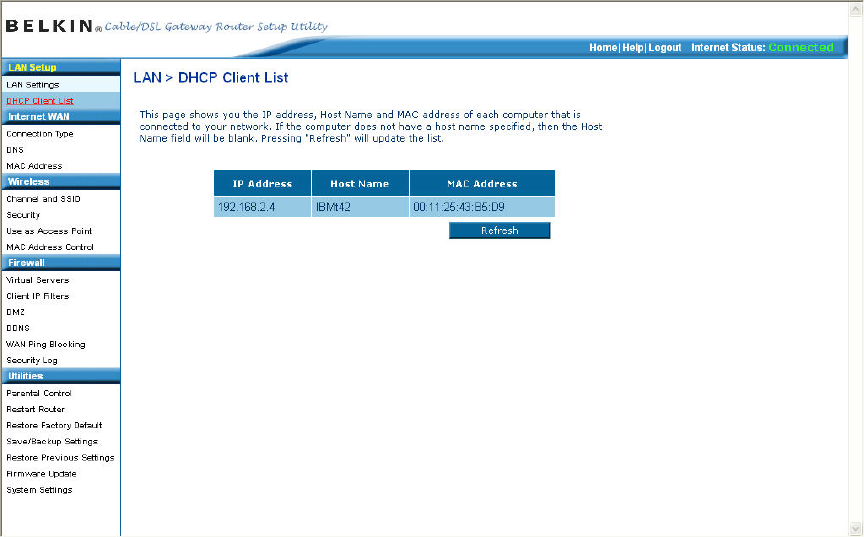
Configuring the Wireless Network Settings
The “Wireless” tab lets you make changes to the wireless network settings. From
this tab you can make changes to the wireless network name (SSID), operating
channel, encryption security settings, and configure the Router to be used as an
access point.
Changing the Wireless Network Name (SSID)
To identify your wireless network, a name called the SSID (Service Set Identifier)
is used. The SSID is your network name. The default network name of the
Router is “Belkin_N1_Wireless_” followed by six digits that are unique to your
Router. Your network name will look something like
“Belkin_N1_Wireless_012345”. You can change this to anything you choose, or
you can leave it unchanged. Keep in mind, if you decide to change your wireless
network name, and there are other wireless networks operating in your area,
your network name needs to be different from other wireless networks that may
be operating in your area. To change the SSID, type in the SSID that you want to
use in the SSID field (1) and click “Apply Changes” (2). The change is immediate.
If you make a change to the SSID, your wireless-equipped computers may also
need to be reconfigured to connect to your new network name. Refer to the
documentation of your wireless network adapter for information on making this
change.
N1 Wireless Router.doc Page 43 of 100

N1 Wireless Router.doc Page 44 of 100
Using the Wireless Mode Switch
This switch allows you to set the Router’s wireless modes. There are three
modes.
1) 802.11g only
Setting the Router to this mode will allow only G Plus MIMO and 802.11g-
compliant devices to join the network, keeping out any slower 802.11b devices.
2) 802.11g & 802.11b
Setting the Router to this mode will let 802.11g-, and 802.11b-compliant devices
to join the network.
3) Off
This mode will turn OFF the Router’s access point, so no wireless devices can
join the network. Turning off the wireless function of your Router is a great way to
secure your network when you are away from home for a long period of time, or
don’t want to use the wireless feature of the Router at a certain time.
Changing the Wireless Channel
There are a number of operating channels you can choose from. In the United
States, there are 11 channels. In the United Kingdom and most of Europe, there
are 13 channels. In a small number of other countries, there are other channel
requirements. Your Router is configured to operate on the proper channels for
the country you reside in. The channel can be changed if needed. If there are
other wireless networks operating in your area, your network should be set to
operate on a channel that is different than the other wireless networks.
Auto Channel Selection Feature and Changing the Channel
For best performance, your Router should use a channel that is at least five
channels away from the other wireless networks in the area. For instance, if
another network is operating on channel 11, then set your network to channel 6
or below. The auto channel selection mode will choose the clearest channel to
operate on when the Router is first powered up. Your Router ships from the
factory with the auto channel feature enabled. You can manually select a channel
if you wish; however, it is recommended to use the auto channel mode. To
change the channel, select the channel from the drop-down list. Click “Apply
Changes”. The change is immediate.
Using the Broadcast SSID Feature
Note: This advanced feature should be employed by advanced users only. For
security, you can choose not to broadcast your network’s SSID. Doing so will
keep your network name hidden from computers that are scanning for the
presence of wireless networks. To turn off the broadcast of the SSID, remove the
check mark from the box next to “Broadcast SSID”, and then click “Apply
Changes”. The change is immediate. Each computer now needs to be set to
connect to your specific SSID; an SSID of “ANY” will no longer be accepted.
Refer to the documentation of your wireless network adapter for information on
making this change.
Protected Mode Switch
Protected mode will ensure proper operation of 802.11g devices on your N1
Wireless network when 802.11b devices are present or when there is heavy
802.11b traffic in the operating environment. If you are using a mix of Belkin N1
Wireless Cards and 802.11b or 802.11g cards on your network, protected mode
should be used. If you are in an environment where there is no other (or very
little) 802.11b wireless network traffic, best 802.11g performance may be
achieved with protected mode OFF. If you are operating in an environment with
HEAVY 802.11b traffic or interference, best 802.11g performance may be
achieved with protected mode ON. N1 Wireless performance is not affected by
this setting.
Changing the Wireless Security Settings
Your Router is equipped with the latest security standard called Wi-Fi Protected
Access (WPA). It also supports the legacy security standard called Wired
N1 Wireless Router.doc Page 45 of 100
N1 Wireless Router.doc Page 46 of 100
Equivalent Privacy (WEP). By default, wireless security is disabled. To enable
security, you will need to determine which standard you want to use. To access
the security settings, click “Security” on the “Wireless” tab.
The Router features WPA2, which is the second generation of the WPA-based
802.11i standard. It offers a higher level of wireless security by combining
advanced network authentication and stronger Advanced Encryption Standard
(AES) encryption methods.
WPA2 Requirements
IMPORTANT: In order to use WPA2 security, all your computers and wireless
client adapters must be upgraded with patches, driver, and client utility software
that supported WPA2. At the time of this User Manual’s publication, a couple
security patches are available, for free download, from Microsoft®. These
patches work only with the Windows XP operating system. Other operating
systems are not supported at this time.
For Windows XP computers that do not have Service Pack 2 (SP2), a file
from Microsoft called “Windows XP Support Patch for Wireless Protected
Access (KB 826942)” is available for free download at
http://support.microsoft.com/?kbid=826942
For Windows XP with Service Pack 2, Microsoft has released a free
download to update the wireless client components to support WPA2
(KB893357). The update is available from:
http://support.microsoft.com/default.aspx?scid=kb;en-us;893357
IMPORTANT: You also need to ensure that all your wireless client
cards/adapters support WPA2, and that you have downloaded and installed the
latest driver. Most of the Belkin wireless cards have driver updates available for
download from the Belkin support site: www.belkin.com/networking.
Setting WPA/WPA2-Personal (PSK)
Like WPA security, WPA2 is available in both WPA2-Personal (PSK) mode and
WPA2-Enterprise (RADIUS) mode. Typically, WPA2-Personal (PSK) is the mode
that will be used in a home environment, while WPA2-Enterprise (RADIUS) is
implemented in a business environment where an external radius server
distributes the network key to the clients automatically. This guide will focus on
WPA2-Personal (PSK) usage. Please refer to the User Manual for more
information about wireless security and different types of wireless security.
1. After you’ve set up your Router, go to the “Security” page under “Wireless”
and select “WPA/WPA2-Personal (PSK)” from the “Security Mode” drop-down
menu.
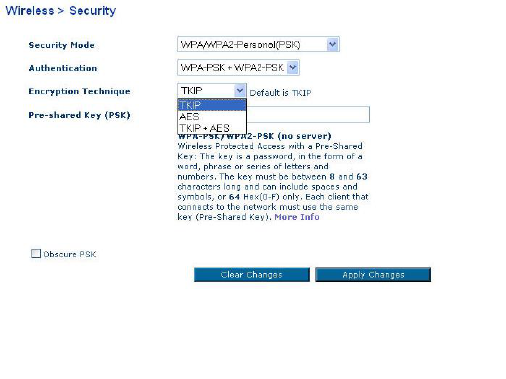
2. For “Authentication”, select “WPA-PSK”, “WPA2-PSK”, or “WPA-PSK +
WPA2-PSK”. This setting will have to be identical on the wireless clients that
you set up. “WPA-PSK + WPA2-PSK” mode will allow the Router to support
clients running either WPA or WPA2 security.
3. For “Encryption Technique”, select “TKIP”, “AES”, or “TKIP+AES”. This
setting will have to be identical on the wireless clients that you set up.
5. 4. Enter your pre-shared key (PSK). This can be from eight to 63 characters
and can be letters, numbers, or symbols. This same key must be used on all
of the wireless clients that you set up. For example, your PSK might be
something like: “Smith family network key”. Click “Apply Changes” to finish.
You must now set all wireless clients to match these settings.
IMPORTANT: Make sure your wireless computers are updated to work with
WPA2 and have the correct settings to get proper connection to the Router.
Setting WPA Security
Note: To use WPA security, your wireless network cards must be equipped with
software that supports WPA. At the time this User Manual was published, a
security patch from Microsoft is available for free download. This patch works
only with Windows XP.
Your Router supports WPA-PSK (no server). WPA-PSK uses what is known as a
pre-shared key as the security key. A pre-shared key is basically a password that
is between eight and 39 characters long. It can be a combination of letters,
numbers, or characters. Each client uses the same key to access the network.
Typically this is the mode that will be used in a home environment.
Setting WPA-PSK
1. From the “Security Mode” drop-down menu, select “WPA-PSK (no server)”.
N1 Wireless Router.doc Page 47 of 100
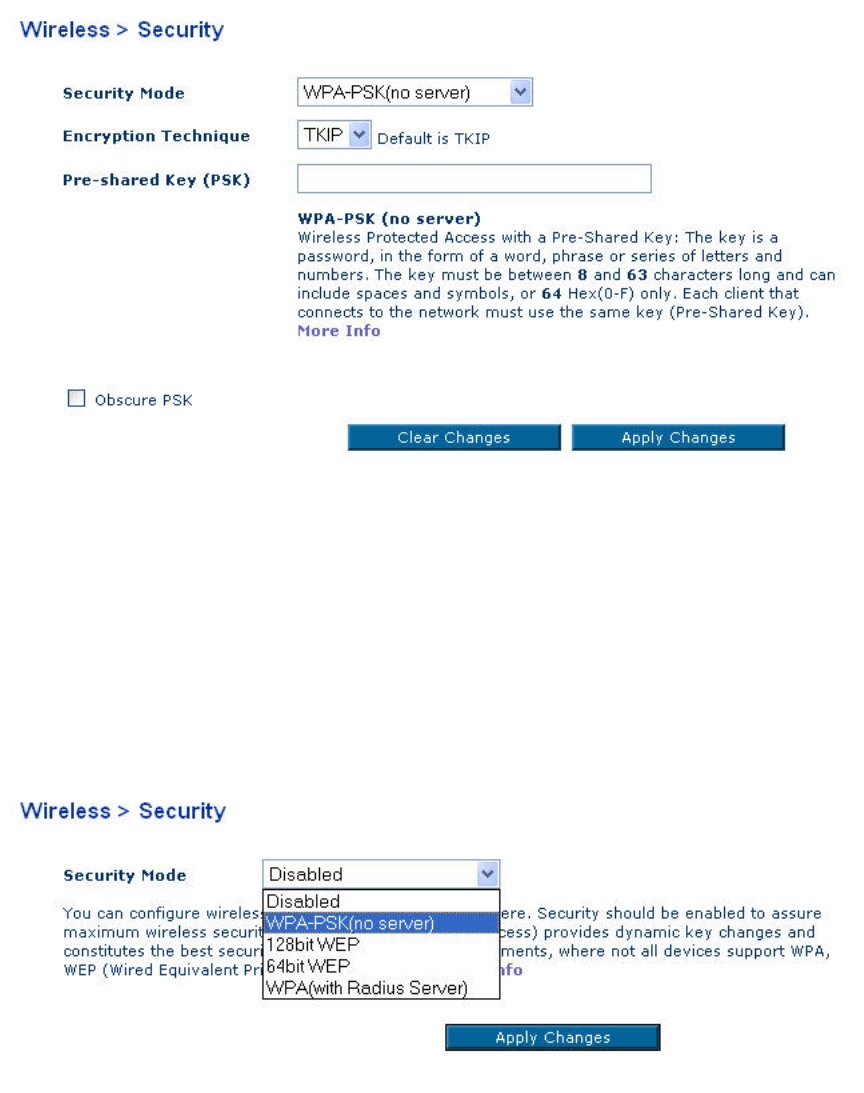
N1 Wireless Router.doc Page 48 of 100
2. For “Encryption Technique”, select “TKIP” or “AES”. This setting will have to
be identical on the clients that you set up.
3. Enter your pre-shared key. This can be from eight to 39 characters and can
be letters, numbers, or symbols. This same key must be used on all of the
clients that you set up.
4. Click “Apply Changes” to finish. You must now set all clients to match these
settings.
Setting WEP Encryption
Note to Mac users: The “Passphrase” option will not operate with Apple®
AirPort®. To configure encryption for your Mac computer, set the encryption using
the manual method described in the next section.
1. Select “128-bit WEP” or “64-bit WEP” from the drop-down menu.
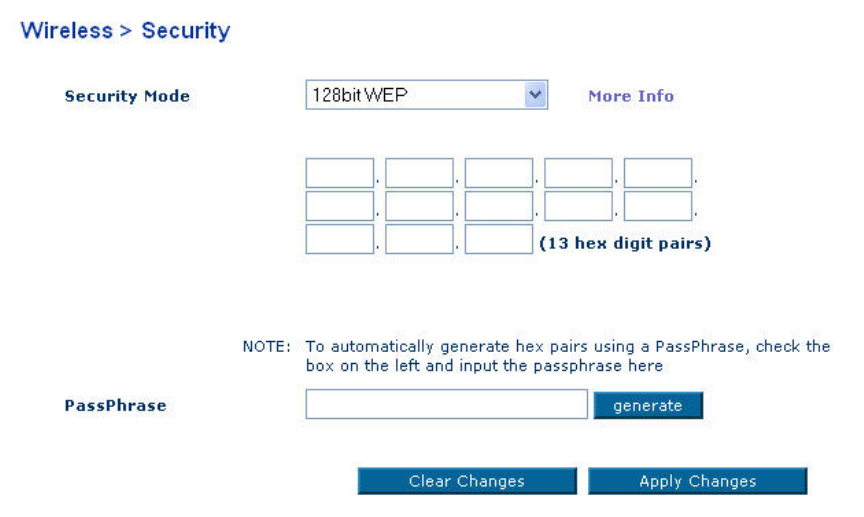
[replace with 8231_Wireless_Security_Mode.jpg]
2. After selecting your WEP encryption mode, you can enter you WEP key
manually by typing in the hex WEP key manually, or you can type a
passphrase in the “PassPhrase” field and click “Generate” to create a WEP
key from the passphrase. Click “Apply Changes” to finish. You must now set
all of your clients to match these settings.
3. Encryption in the Router is now set. Each of your computers on your wireless
network will now need to be configured with the same passphrase. Refer to
the documentation of your wireless network adapter for information on making
this change.
Using a Hexadecimal Key
A hexadecimal key is a mixture of numbers and letters from A–F and 0–9. 64-bit
keys are 10 digits long and can be divided into five two-digit numbers. 128-bit
keys are 26 digits long and can be divided into 13 two-digit numbers.
For instance:
AF 0F 4B C3 D4 = 64-bit key
C3 03 0F AF 0F 4B B2 C3 D4 4B C3 D4 E7 = 128-bit key
In the boxes below, make up your key by writing in two characters between A–F
and 0–9. You will use this key to program the encryption settings on your Router
and your wireless computers.
N1 Wireless Router.doc Page 49 of 100

N1 Wireless Router.doc Page 50 of 100
Note to Mac users: Original Apple AirPort products support 64-bit encryption
only. Apple AirPort 2 products can support 64-bit or 128-bit encryption. Please
check your product to see which version you are using. If you cannot configure
your network with 128-bit encryption, try 64-bit encryption.
Using the Access Point Mode
Note: This advanced feature should be employed by advanced users only. The
Router can be configured to work as a wireless network access point. Using this
mode will defeat the NAT IP sharing feature and DHCP server. In AP mode, the
Router will need to be configured with an IP address that is in the same subnet
as the rest of the network that you will bridge to. The default IP address is
192.168.2.254 and subnet mask is 255.255.255.0. These can be customized for
your need.
1. Enable the AP mode my selecting “Enable” in the “Use as Access Point only”
page. When you select this option, you will be able to change the IP settings.
2. Set your IP settings to match your network. Click “Apply Changes”.
3. Connect a cable from the WAN port on the Router to your existing network.
The Router is now acting as an access point. To access the Router advanced
user interface again, type the IP address you specified into your browser’s
navigation bar. You can set the encryption settings, MAC address filtering, SSID,
and channel normally.
Setting MAC Address Control
The MAC address filter is a powerful security feature that allows you to specify
which computers are allowed on the wireless network. Note: This list applies only
to wireless computers. This list can be configured so any computer attempting to
access the wireless network that is not specified in the filter list will be denied
access. When you enable this feature, you must enter the MAC address of each
client (computer) to which you want to allow network access. The “Block” feature
lets you turn on and off access to the network easily for any computer without
having to add and remove the computer’s MAC address from the list.